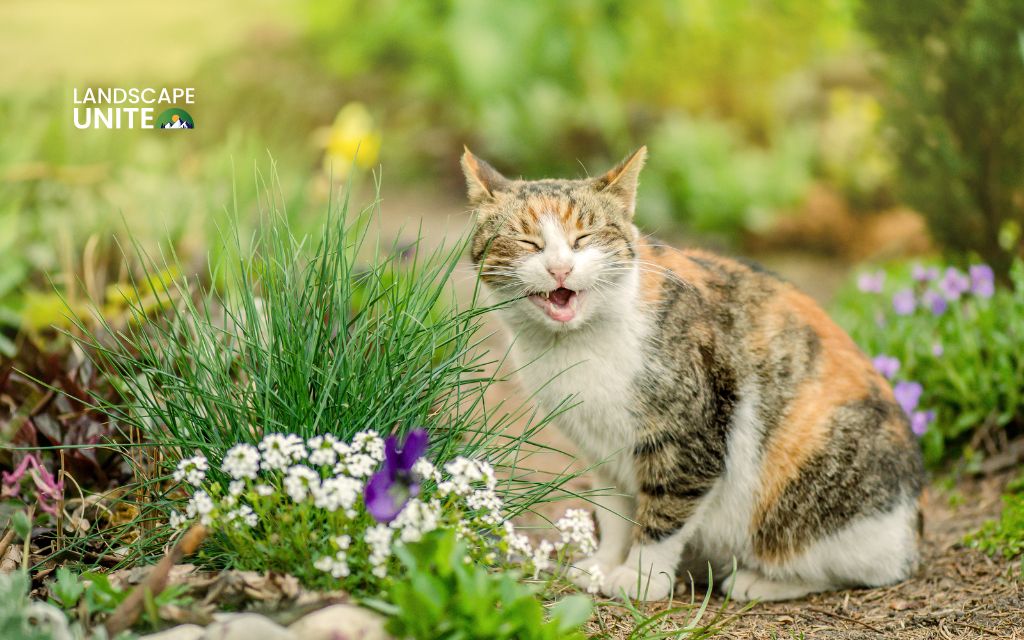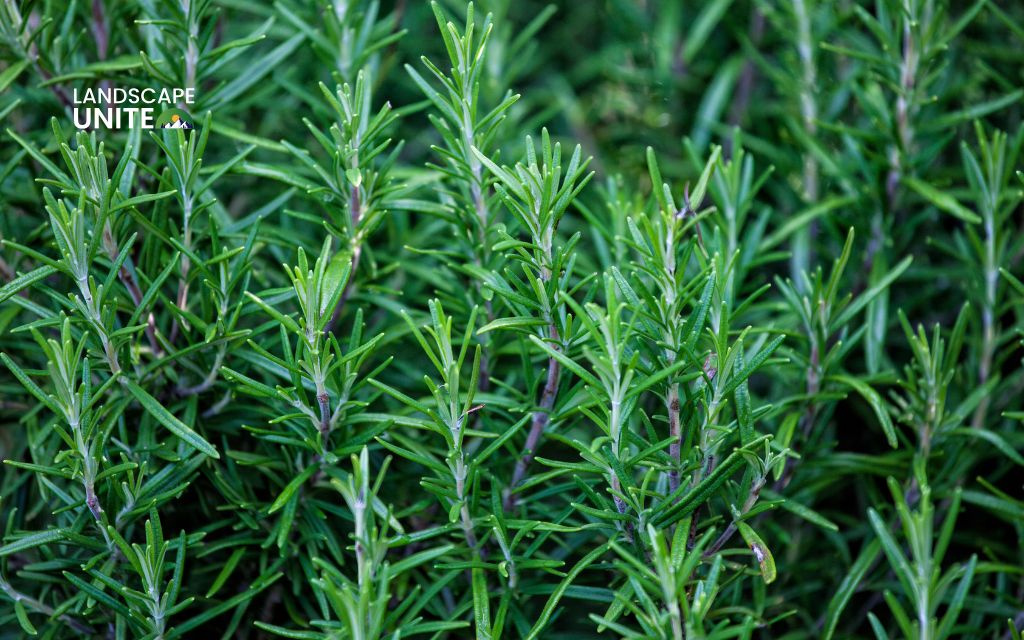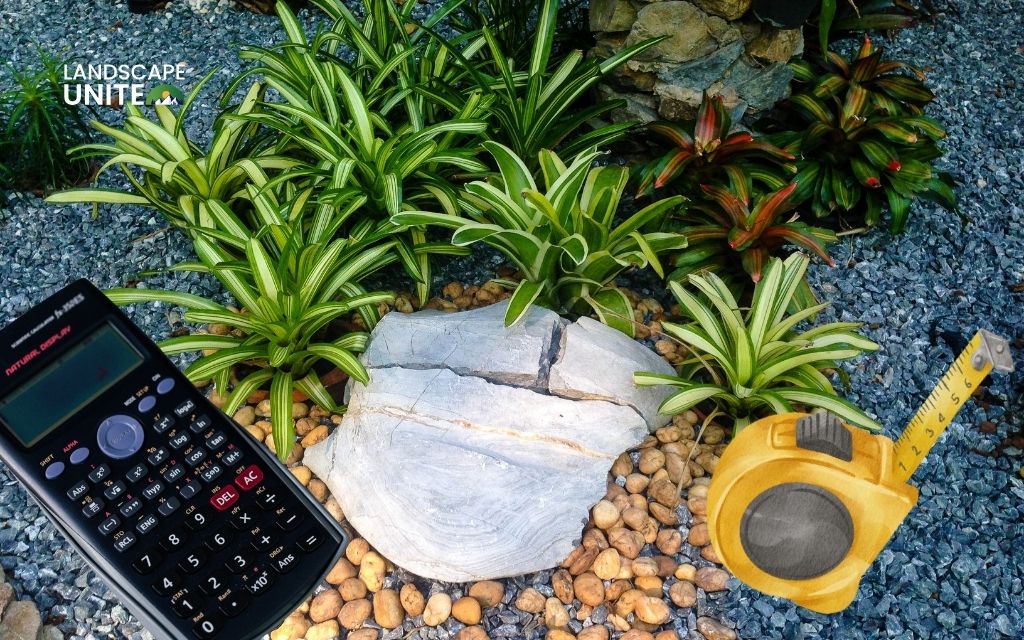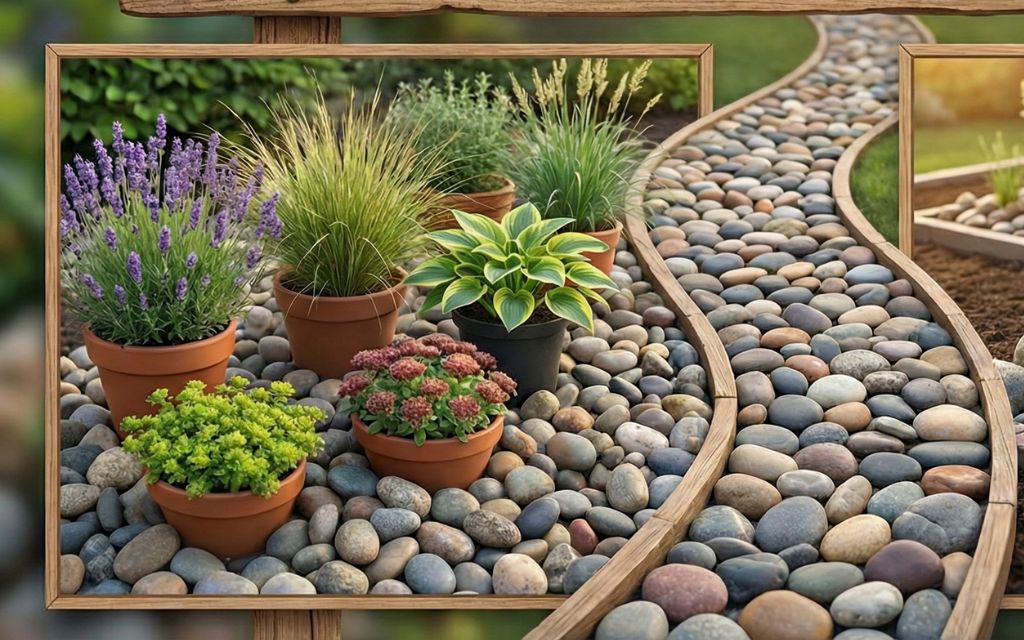Nothing frustrates a gardener more than discovering freshly planted seedlings uprooted or pristine flower beds turned into impromptu litter boxes.
If you’re dealing with feline visitors wreaking havoc on your carefully cultivated garden, you’re not alone. Millions of American homeowners face this challenge, but the good news is that effective, humane solutions exist to reclaim your flower beds without harming these curious creatures.
Understanding why cats are drawn to your garden is the first step toward successful deterrence.
Armed with the right combination of physical barriers, natural repellents, and strategic garden modifications, you can create a beautiful, cat-free sanctuary that thrives season after season.
Want to learn more helpful guides for your flower beds? Check out these:
- Grubs ruining your garden? Here’s how to stop them before they spread
- 12+ creative ideas for maximizing your garden with potted plants in flower beds
- Keep chickens away from flower beds with these 8 easy, natural methods
- Say goodbye to grass in your flower beds with these 4 simple solutions
How to keep cats out of flower beds
To deter cats from flower beds effectively, using physical barriers, aromatic deterrents, and environmental modifications. Consider installing chicken wire or mesh coverings, applying citrus-based repellents, and incorporating motion-activated devices.
Strategic placement of uncomfortable surfaces like pine cones or stone mulch, combined with thorny border plants, creates an unwelcoming environment while maintaining your garden’s aesthetic appeal.

1. Use physical barriers
Physical barriers represent your first line of defense against feline intruders, offering immediate protection for vulnerable plants and soil areas.
Chicken wire or mesh coverage
Cover your flower beds with chicken wire or fine mesh, securing the edges with landscape staples or small rocks. This creates an effective physical barrier that prevents cats from digging while allowing plants to grow through the openings.
Choose galvanized wire to prevent rust, and cut access holes around established plants to maintain proper air circulation and watering access.
Decorative garden fencing
Install low decorative fencing or plant edging around flower bed perimeters to establish clear boundaries. Ornamental metal edging or bamboo fencing works particularly well, providing both functional protection and visual appeal.
Ensure fencing height reaches at least 12 inches, as cats are excellent jumpers and may view lower barriers as merely minor obstacles.
Spiky deterrent mats
Place commercial spike mats or garden rollers strategically across vulnerable areas. These humane devices feature plastic spikes that are uncomfortable but not harmful to cat paws.
Position them around newly planted areas or where cats frequently attempt entry, rotating placement periodically to prevent habituation.
2. Repellents and deterrents
Scent-based deterrents exploit cats’ sensitive olfactory systems, creating invisible barriers that encourage them to seek more appealing territories elsewhere.
Natural scents and essential oils
Cats possess an aversion to specific strong scents that you can harness for garden protection.
- Scatter fresh citrus peels throughout flower beds, focusing on areas where cats typically enter.
- Orange and lemon peels work exceptionally well, but replace them regularly as effectiveness diminishes once oils evaporate.
- Essential oils provide longer-lasting protection when applied correctly. Mix lavender, eucalyptus, or cinnamon essential oils with water in a spray bottle, applying to mulch and soil surfaces every few days.
- Avoid direct application to plant leaves, as concentrated oils may cause damage to sensitive vegetation.

Spice-based deterrents
Sprinkle cayenne pepper or garlic powder around flower bed edges and entry points. These potent scents create an unwelcoming environment for cats while remaining safe for plants and beneficial insects. Reapply after rain or heavy watering, as moisture reduces effectiveness significantly.
Commercial cat repellents
- Invest in high-quality, plant-safe commercial repellents containing proven ingredients like citronella, neem oil, or predator urine concentrates.
- These professionally formulated products often provide superior longevity compared to homemade alternatives.
- Apply according to manufacturer instructions, typically requiring reapplication every 2-3 weeks for optimal effectiveness.
3. Motion-activated deterrents
Technology offers solutions for persistent cat problems, providing startling but harmless deterrence when other methods prove insufficient.
Motion-activated sprinklers
Install motion-sensor sprinkler systems that detect movement and respond with sudden water bursts. Cats instinctively avoid water and unexpected movements, making these devices effective for larger garden areas.
Position sprinklers to cover primary entry routes while avoiding unnecessary watering of established plants during dry periods.
Ultrasonic repellent devices
Deploy ultrasonic devices that emit high-frequency sound waves unpleasant to feline hearing but completely inaudible to humans.
These battery-operated or solar-powered units provide 24-hour protection without ongoing maintenance requirements.
Place multiple units throughout larger gardens, ensuring adequate coverage of all vulnerable areas.
4. Mulch with sharp materials
Transform your garden’s ground covering into a natural deterrent system that discourages digging while providing traditional mulching benefits.
Uncomfortable mulch alternatives
Replace soft, loose mulch with materials that feel unpleasant under cat paws. Pine cones, decorative stones, or coarse gravel create surfaces cats prefer to avoid while maintaining proper soil moisture and temperature regulation.
Choose materials that complement your garden’s aesthetic while serving this dual purpose effectively.
Sharp-edged natural materials
Incorporate mulch varieties with naturally sharp edges, such as holly leaves or pine needles, around vulnerable plant bases.
These materials make digging uncomfortable without causing injury, encouraging cats to seek softer digging locations elsewhere in your neighborhood.
Check out this guide to learn how to mulch properly: Mulching flower beds made easy – 4 steps to a healthier, thriving garden.

5. Change the soil texture
Modify soil composition and surrounding plantings to create an environment naturally unappealing to feline visitors.
Thorny border plants
Establish borders using plants with natural defensive features like roses, holly, or barberry bushes.
These living barriers provide year-round protection while adding structural interest and seasonal beauty to your garden design.
Space plantings appropriately to prevent gaps that cats might exploit as entry points.
Soil texture modifications
Cats prefer loose, soft soil for their excavation activities. Mix sand, small rocks, or other coarse materials into flower bed soil to create an uncomfortable digging surface.
This modification also improves drainage for many flowering plants, providing dual benefits for your garden’s health and protection.
6. Create a cat-friendly zone away from your garden
Strategic redirection often proves more effective than pure deterrence, providing cats with attractive alternatives that satisfy their natural behaviors.
Designated cat garden areas
Establish a separate garden section specifically designed to attract cats away from your prized flower beds. Plant catnip, cat grass, or valerian in this area, creating an irresistible destination that diverts feline attention from your protected spaces.
Alternative elimination areas
Provide a designated sandy area or loose soil patch away from flower beds where cats can safely conduct their bathroom activities. This proactive approach acknowledges natural cat behaviors while protecting your cultivated areas from unwanted deposits.
7. Use cat-friendly plants
Strategic plant selection can work both for and against your cat deterrence goals, depending on placement and variety choices.
Attractive plants for diversion
Incorporate cat-attracting plants like catnip, catmint, or valerian in designated areas far from your main flower displays. These plants act as natural magnets, drawing cats toward specific locations while leaving your primary gardens undisturbed.
Repellent plants for protection
Surround vulnerable flower beds with plants cats naturally avoid due to their strong fragrances.
Lavender, rosemary, citronella grass, and rue create pleasant borders for humans while serving as living deterrents for feline visitors.

8. Install cat-proof barriers for elimination prevention
Address the most frustrating aspect of cat garden visits with targeted solutions designed to prevent soil contamination.
Protective ground coverings
Install plastic mesh or chicken wire flat against soil surfaces in areas where cats frequently eliminate. These barriers prevent access to soft soil while allowing proper air and water circulation for plant roots beneath.
Textured deterrent surfaces
Place plastic mats featuring raised bumps or uncomfortable textures over vulnerable soil areas. These commercially available products discourage elimination activities without harming cats or interfering with plant growth when properly positioned.
Why cats are drawn to flower beds
Understanding feline motivations provides crucial insight for developing effective deterrence strategies tailored to specific behavioral triggers.
Natural territorial instincts
Cats are inherently territorial creatures that seek to establish and maintain control over specific areas within their perceived domain.
Soft, loose soil found in flower beds provides an ideal surface for digging and marking activities that reinforce territorial claims. This behavior intensifies during breeding seasons and when new cats enter established territories.
Environmental comfort factors
Flower beds often provide multiple attractive features for cats including cool, shaded areas during hot weather, soft surfaces for lounging, and interesting scents from various plants and soil amendments.
Freshly watered soil creates particularly appealing conditions that cats find irresistible for both elimination and comfort activities.
Conclusion
Keep cats out of flower beds by combining multiple methods: install physical barriers, apply scent repellents, change soil texture, and create alternative cat areas. Success requires consistency and patience. Start with 2-3 methods that fit your garden and budget, then add more if needed.
Most effective combinations include chicken wire barriers with citrus repellents, or thorny border plants with motion sprinklers. Maintain your chosen methods regularly for long-term success.
Learn more from our garden resources to level up your gardening skills and discover additional tips for creating the perfect flower garden sanctuary.
Frequently asked questions (FAQs)
How can I stop cats from pooping in my flower beds?
Use chicken wire ground covering, apply citrus peels or commercial repellents, and remove waste immediately. Consistency is key for breaking the habit.
What are the best cat repellents for flower beds?
Citrus peels and lavender work naturally. Commercial repellents with citronella or predator urine last longer. Motion sprinklers are most effective for persistent problems.
How can I prevent cats from digging in my flower beds?
Install chicken wire barriers, use rough mulch like pine cones, plant thorny borders, and provide alternative digging areas with catnip.
Are these solutions safe for cats?
Yes, all recommended methods create discomfort without harm. Avoid toxic substances and focus on making beds less appealing rather than dangerous.
What plants effectively deter cats?
Lavender, rosemary, citronella grass, and rue repel cats with strong scents. Thorny plants like roses and holly create physical barriers cats avoid.


